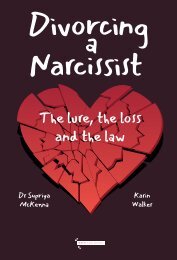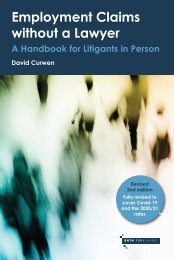Insolvency Made Clear: A Guide for Debtors
Plain English, practical guidance for anyone facing demands over a debt they are struggling to pay.
Plain English, practical guidance for anyone facing demands over a debt they are struggling to pay.
You also want an ePaper? Increase the reach of your titles
YUMPU automatically turns print PDFs into web optimized ePapers that Google loves.
Introduction And Aim Of This Book<br />
A further 17,000 companies went insolvent in 2019. Of these, 12,000 were voluntary<br />
liquidations (see Chapter 12); 3,000 were compulsory (see Chapter 13);<br />
and 2,000 were administrations (Chapter 12) 1 . The most common sector <strong>for</strong> the<br />
companies is construction, followed by wholesale and retail trade. This book<br />
tries to help directors of companies going insolvent; and advise individuals who<br />
are facing ‘directors’ disqualification orders’ as a result (see Chapter 14).<br />
Principles of insolvency law<br />
Describing some basic principles behind insolvency law will put the rules and<br />
arguments which follow in this book into their proper context.<br />
The purpose of bankruptcy is to transfer management of the bankrupt’s assets<br />
to an independent professional, known as a ‘Trustee in Bankruptcy’. The Trustee<br />
can then organise the sale of these assets, gather in<strong>for</strong>mation about who the<br />
creditors are, and distribute the proceeds according to the scheme set out in the<br />
<strong>Insolvency</strong> Act 1986. The Trustee can also recover assets by reviewing transactions<br />
made by the bankrupt be<strong>for</strong>e bankruptcy. A Trustee can undo the transactions<br />
which unfairly harm the creditors, or favour one creditor over the others.<br />
Finally, the Trustee can investigate the circumstances of the bankruptcy and<br />
the conduct of the bankrupt. If necessary, the Trustee can refer any possible<br />
criminal offences to the <strong>Insolvency</strong> Service <strong>for</strong> prosecution or <strong>for</strong> an order that<br />
certain restrictions continue to protect any future creditors.<br />
The focus of bankruptcy is the ‘class’ of creditors, i.e. the creditors of a bankrupt<br />
as a whole. This has several important implications:<br />
1. Firstly, the creditor who brings (‘presents’) the petition is not given any<br />
special treatment. If something is in the interests of the creditors as a whole<br />
but not in the interests of the petitioning creditor, the court’s instinct will<br />
be to protect the class.<br />
2. The court will treat all creditors equally, within the statutory scheme. In<br />
particular, all the ‘unsecured’ creditors will be treated the same way. They<br />
will each receive a distribution in the bankruptcy which is proportionate<br />
to their debt. For example, if one creditor is owed £10,000 and another is<br />
owed £5,000, and the Trustee only has £1,500 to distribute, then the proceeds<br />
will be split 2:1, and each creditor will receive 10p <strong>for</strong> every pound<br />
owed. ‘Secured’ creditors are entitled to the proceeds of sale of a particular<br />
asset – <strong>for</strong> example, a bank who provides a mortgage over a house will be<br />
repaid from the proceeds once the house is sold. ‘Unsecured’ creditors are<br />
owed money without the benefit of receiving the proceeds of the sale of any<br />
1<br />
There were also a small number of receiverships which this book does not discuss.<br />
xxxi













